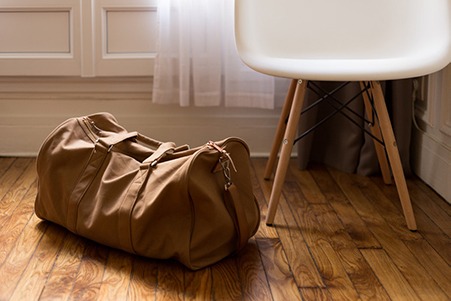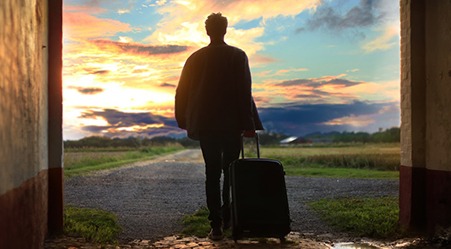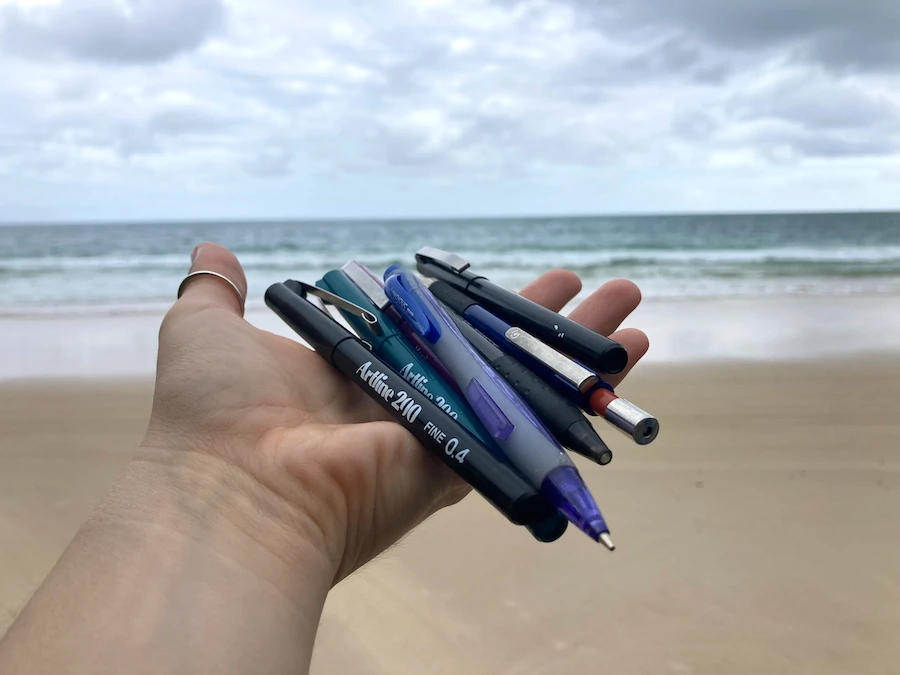
Traveling can be a time when we are prone to producing more waste than normal because we are not following our daily routines and practices so I’ve created some tips for you to follow for zero waste travel.
Zero waste is a movement with the goal of producing the lowest amount of waste as possible in all aspects of life. You will find that zero waste is a mindset and way of living. Some of the basic principles of zero waste living are to refuse, reduce, and reuse. This will also apply to your choices when traveling.
So what are the best tips for zero waste travel?
The Best Zero Waste Travel Tips
The Essential Items
1. Reusable Water Bottle
Whether you are traveling halfway around the world, or just on the go running daily errands, a reusable water bottle is a must for zero waste travel. In most public places and establishments you can easily refill your bottle with fresh water free of charge. It will also spare you from consuming any waste from single-use water bottles or beverages.
Choose one that is lightweight and durable but large enough to hold the amount of liquid you need when you venture away from home. Stainless steel or aluminum make great eco-friendly options. The Kleen Kanteen Wide Mouth Double Wall Insulated Bottle (link to read reviews on Amazon) works great as it can be clipped on to any bag you may be traveling with. Before you go through airport security make sure your water bottle is empty so it doesn’t get confiscated!
2. Handkerchief
Save yourself from carrying around tissues or wipes which leave waste after each use. Having a handkerchief accessible can come in handy while you are on your adventure. Use them for a messy nose, clearing that sweat off your brow, or any other unexpected mess that may occur while traveling. It can also come as the last resort emergency for toilet paper or diapers, so pack several to be prepared!
3. Cloth Napkin
A cloth napkin will be the same as your handkerchief but one that is reserved for your food. Wrap up any dried takeaway food from the bakery or use it as an impromptu placemat when enjoying a snack during a traveling pitstop. I love trying out fresh fruit and nuts from local vendors so I can use the cloth to securely wrap up for storage later.
4. Mason Jar

One of my favorites things to do when traveling is eating and drinking. A mason jar is a perfect all-purpose storage container that you can use for just about anything! Fill up your mason jar with fresh iced coffee to sip on or store your dried snacks to enjoy throughout the day. A 16oz jar will surprisingly fit a large number of dried foods but an 8oz or 4oz can fit in the smallest of spaces in your bag. No need for any storage containers or plastic cups. Made of glass and easily washable, a mason jar is a zero waste travel essential.
5. Biodegradable Toothbrush
Packing a toothbrush for traveling is usually one of the first things I pack away. Stay away from plastic travel-sized toothbrushes that will end up getting tossed and use an eco-friendly biodegradable toothbrush.
A bamboo toothbrush is a fantastic option due to its antibacterial and biodegradable properties as a material and its sustainability as a renewable resource. They are lightweight and come with a traveling case. When it’s life is up, simply compost your bamboo toothbrush into the earth instead of polluting the environment as a plastic toothbrush would.
6. Cloth Tote Bag
A cloth tote bag is the perfect carrier bag to use when venturing out for the day. It’s foldable and can be easily packed without taking up much space. When shopping, instead of using a plastic bag offered by the store just throw your items into your tote bag and away you go. These also work great for when exploring the city or heading for a day at the beach.
Packing Tips
7. Limit Your Load

By simply limiting the number of clothing and toiletries you take while traveling you will reduce your waste and have a much lighter load to carry around. Before packing, make a comprehensive list of your necessities while traveling. One of the central ideas behind zero waste travel is reducing your use. Try to cut this list in half before packing.
If you forget an item or run into an absolute emergency while traveling, you can also purchase something from a local or secondhand thrift store.
8. Eco-Friendly Toiletries
Pack only eco-friendly toiletries, which should be plastic-free and have very limited packaging. Stay away from large amounts and those which come in big containers.
For feminine hygiene, a reusable menstrual cup is an eco-friendly option that will be more versatile than single-use pads or tampons when traveling. The Lena Menstrual Cup (link to read reviews on Amazon) is eco-conscious and will also save you space in your carry-on bag.
You can also make your own homemade toiletries and store them in stainless steel containers or small glass jars. This will save you money while lightening your load and limiting your waste.
9. Avoid Single-Use Toiletries
Stay away from any single-use travel-sized toiletry products. Not only are these inefficient and get thrown out after traveling they usually come packaged with excessive amounts of paper and single-use plastic.
If you already have your favorite eco-friendly liquid toiletries, you can simply transfer them into a small travel-sized container that is allowed in your carry-on baggage (under 3oz or 100ml). This also you saves you the hassle of trying to fit your larger sized toiletries into your checked baggage.
10. Think Multipurpose
Think of packing items that can have multiple uses or be combined, such as an all-purpose soap bar which can serve as a way to wash the face, hands, and body. Shampoo and conditioner are available in solid soap bar forms and can be stored in a stainless steel container. Toothpaste can be made from a simple homemade recipe and then transferred into a small glass jar. Reusable cotton pads can replace single-use makeup remover pads. Look at your makeup and skincare routine and find ways to consolidate different items before your travels.
11. Capsule Wardrobe
Make a capsule wardrobe by picking out your favorite and most-versatile outfits. The goal is to bring items that can be easily mixed and matched with each other to maximize the number of outfits you can wear while packing as little clothing as possible. Pick a neutral color palette for your outfits by sticking to black, white, gray, and tan.
Make sure they are items you can layer to be prepared for any unexpected weather change at your destination. These should also be items that are durable and you can wear repeatedly before having to wash. Not only will this give you options and also save you packing space. If you need to laundry while traveling an essential capsule wardrobe can be done in a matter of hours.
Avoid packing one-off items or anything that you don’t wear on a regular basis. If you don’t wear it at home, chances are you won’t wear it while traveling!
12. Pack a Carry-On
Always opt for carry-on luggage when possible. The more cargo weight on the airplane for checked baggage, the more fuel it will need to use, thus emitting more CO2 into the air. If you are worried about having enough space in your carry-on bag, keep in mind that many airlines also allow a smaller personal item too.
Packing a carry-on bag will limit the number of items you can pack due to security liquid restrictions thus reducing your travel waste. You will also be saved from the stress of having to check a larger bag and potentially having it lost. Zero fun. Anyone who has lost a checked bag can attest to this.
When traveling away for a longer period, prepare your carry-on bag with an extra change of clothes just in case things go awry with your checked baggage. Wear your bulkiest clothing on the plane so you can save room in your carry-on.
13. Quart Sized Bag for Liquids
Now I am never a proponent of using plastic bags but due to security requirements, you must put your carry-on liquids into a TSA approved quart-sized transparent bag. There are many options that are durable with a secure seal. If you take care of it, it will last a long time and can be reused for future travel. Your liquids should all be under 3oz (100ml) and securely fit into your quart-sized bag.
Before You Go
14. Check the Fridge
Have a look through your refrigerator before you set off on your trip. Consume the last of your perishable so it doesn’t go to waste. If you don’t have a ton of time for cooking due to packing and preparing for your trip opt to freeze your perishables.
Extra fruits and vegetables can be frozen and used as a juice or smoothie for later use. Wrap up any extra meat with paper and stick it in the fridge until you return. Give away any extra perishable foods you have to neighbors or coworkers. Anything else that you can not consume, freeze, or give away should be composted.
15. Sleep Mode Your Home

Put your home in “sleep mode” by preparing it to reduce any waste before you go away. Any electronics or lamps with an off switch should be unplugged, as it can still consume energy when plugged in. Turn off the heat to further save energy and while also reducing your heating bill. If going away for the winter, it is not recommended to completely turn off the heat as cold weather can cause pipes to freeze and burst. This would not be a fun surprise to return home to! To avoid this, lower the thermostat to around 50 degrees.
16. Book Direct flights
When possible, book direct flights to limit your flight’s fuel emissions. This may be a more expensive choice, but it will get you to your destination quicker while reducing your carbon footprint from air travel.
17. Offset Your Emissions
Carbon offsets are programs by airlines to offset your CO2 emissions that you have contributed as a passenger. Extra optional fees can be purchased and will go toward programs such as forest replanting, environmental protection, or biodiversity. Many of the biggest airlines in the world offer this as an option for eco-conscious passengers looking to reduce their CO2 footprint during their air travel. This may not be a clear option offered by all airlines during your online purchase so look at any sustainability sections of their site first.
18. Go Paperless
When buying your airline ticket, choose to go paperless by opting for the mobile version of your boarding pass. You can have the boarding pass sent to your email address or text to your mobile phone. Most airlines have an app you can download which will make this process even easier.
When you arrive at the check-in counter, sometimes they will print you a new boarding pass anyway. Refuse this and let them know you have your mobile boarding pass so you can save any potential paper waste.
At the Airport
19. Read an E-Book

Many airports have kiosks and shops where you can buy newspapers, magazines, and books to occupy yourself for your flight. Spare yourself the extra waste (and overpriced items) by reading an e-book. An e-reader is a perfect and versatile option for reading when traveling. There is no need to carry extra books in your luggage or creating extra waste by leaving one behind.
20. Snacks to Go
Delays in air travel can throw all sorts of kinks into your eating routine. Packing several ready to eat snacks will stave off any hunger and keep your patience still functioning. Nuts, fruits, bread, or any other dried food always keep well and can easily pass through airport security and be taken onto the airplane. Dining options at many airports can be very limited and also overpriced so I prefer to pack my own meal and snacks.
In the Air
21. Dress in Layers
When aboard the aircraft temperatures can quickly fluctuate from hot to cold so it’s best to be prepared. On the day of your travel make sure you dress in layers. This will give you the option of shedding a layer to cool down or adding one to warm up. These can also double as a pillow or blanket instead of using the airline offered ones that usually come wrapped up in single-use plastic.
22. Avoid In-Flight Products

Refuse any in-flight products that are offered by airlines. For longer flights, many airlines offer free headphones, earplugs, sleeping masks, blankets, and slippers. These items usually come wrapped in single-use plastic and leave a ton of waste behind even with many of them going unused.
Part of zero waste traveling is being prepared, so make sure you pack ahead of time for any items you will need to stay comfortable during your flight.
23. Be Selective with Drinks
When the beverage cart comes around, ask the flight attendants to fill your drink into your mason jar. If they say no, usually a simple explanation that you wish to reduce your waste or plastic consumption will suffice.
This way you won’t contribute waste by using a plastic cup and straw. Alternatively, you can choose a beverage that comes in an aluminum can and recycle it yourself once when you get off the plane.
24. Dispose of Your Waste Yourself
There is no way to be sure if an airline recycles its waste. The only way you can be 100% sure is to recycle the waste yourself. If you are striving for zero waste travel, you probably won’t be making much waste, to begin with. Make sure you collect any waste you’ve made and bring it to the recycling bins at your destination.
25. Bring Your Own
When airlines serve meals to passengers, they are served and packaged with plastic containers and utensils. Let’s not even talk about the quality of the food!
For zero waste travel, refuse an in-flight meal and instead BYO (bring your own). For shorter flights, filling up a mason jar with snacks does the trick. For longer hauls, you can pack a sandwich or meal that can keep at room temperature.
Out and About
26. Walk the Walk

While at your destination stay out of the car and instead try to walk around as much as possible. This will give you a better sense of direction and also give you some exercise.
In many large cities throughout the United States and Europe, free walking tours are offered. These are a great way to see the city and learn about its history while meeting fellow travelers. Most meet in a central location and give you a 1-4 hour tour throughout the main points in the city. The best part is that its free! You should, however, consider a small gratuity for your tour guide.
27. Public Transport
When moving about, reduce your carbon footprint by staying away from rental cars and taxis and instead use public transport. Most large cities have well-connected buses and metro systems and sometimes even offer discounts for tourist multiple-day passes. Using public transport is a great way to orient yourself to the way locals get around. It will save you a lot of money as taxis are infamous for ripping off out of towners.
28. Stay in Homes
Stay in homes instead of hotels. Companies like Airbnb have made this easily possible nowadays. When staying in someone else’s apartment or home you can recycle, compost, and cook your own meals, all of which can help your zero waste travel experience.
Couchsurfing is another option for the adventurous traveler. You can connect yourself with a verified host in any city throughout the world and stay as a guest traveler in their house. You will also gain a local’s perspective and enriching cultural experience.
29. Go Green at the Hotel
If you are staying at a hotel, don’t forget to practice zero waste. Hotels can be primary producers of waste with guests always coming and going. Towels and linens are washed daily and travel-sized toiletries are used every day.
Go green by bringing your own microfiber towel or simply reusing your towel for the duration of your stay. Hang your towel up to signal to the housekeeper you don’t want it to be washed. Use your own toiletries instead of the hotel offered ones which are rife with single-use plastic packaging.
30. Avoid Souvenirs
Stay away from cheap and tacky souvenirs. Many souvenirs are low-quality and will only end up collecting dust in the future. Instead, spend your money on experiences such as museums or attending a local festival. If you want to get a gift, purchase one from a local handcraft ship. Using your camera produces zero waste and can create lasting memories instead of buying a useless item.
31. Refuse the Receipt
During all of your travels, when offered a paper receipt, politely refuse. You don’t want the unnecessary extra waste. If you are given the receipt anyways, encourage that establishment to consider how wasteful receipts can be.
Many retailers are starting to offer the option of paperless receipts where the receipt can be emailed to you. This is a great option and you should take it whenever possible.
32. Refuse the Unnecessary
Say “no” to promotional items and unnecessary products. When traveling, its common in airports and tourist spots to see brands and sponsors handing out promotional products. These are most often made from low-quality materials that won’t last long.
Think twice before a paper flyer is handed out or you are offered a free promotional pen and paper pad. If you didn’t actively go out and search for the item, chances are you don’t really need it.
Eating
33. Try Street Food
Instead of dining in or getting takeout, try local street food. Most street foods are easily handheld and free of packaging. It’s a delicious option that will give a taste of local flavors. Politely refuse when offered any extra napkins, straws, or containers. Use your mason jar to fill up with any street food beverages or snacks. Your cloth napkin can also be used as an impromptu storage container.
34. Eat Local

When choosing to dine-in, stay away from commercial restaurants but instead opt for locally-owned restaurants. Local restaurants will offer a better overall dining experience and service. This will also help stimulate the local economy while giving you a sample of local cuisine and culture.
35. Reusable Container for Takeaway
If you do choose to get takeaway food, look for establishments that use eco-friendly, recyclable or compostable food containers, utensils, and napkins. Store your meal in a reusable food container and completely avoid using styrofoam (polystyrene) as there is some evidence it can leach out of containers and into food and drinks. A potential risk that’s not worth taking if you ask me. The Greenlunch Bento Box (link to read reviews on Amazon) is made from non-toxic stainless steel and is space-efficient making it a functional option for any meal outing.
36. Carry Utensils
One of my favorites things to do when traveling is eating and drinking. You never know when an impromptu meal can happen so you must always be prepared! Carry a lightweight bamboo utensil set or spork with you at all times when traveling. These can easily be washed and reused for years. Wrap your utensils in a handkerchief and you can easily store them away until needed.
37. Reusable Straw
Reusable straws come in many different materials such as glass, stainless steel, bamboo, and silicone. Find one that works for you and carry it with you on your travels.
Its no secret these days what single-use plastic straws do to our environment. Many establishments are becoming eco-friendly and zero waste-conscious and have banned plastic straws.
When offered a straw, simply refuse it and use your reusable straw. This works great with nearly every liquid and beverage container, especially your mason jar or reusable water bottle.
Final Thoughts
The best part about traveling the true adventure! You will be exposed to different and sometimes stressful situations but you will also discover new and exciting places so stay patient and be prepared on your zero waste travel journey.
Zero waste travel is just one part of the overall goal of zero waste living. Keep in mind that when we are traveling, we are not following our daily routines and habits so this can make it even more difficult to follow zero waste principles. Develop good habits while at home so they become second nature for you when you are away and abroad.
I hope these tips have been helpful for you when traveling zero waste. There is a myriad of ideas which I’m sure you are creative enough can find out even more. So what are you waiting for? The next time you head out on a journey, give zero waste travel a shot!




